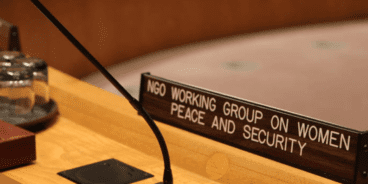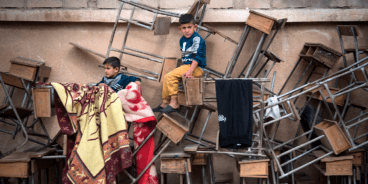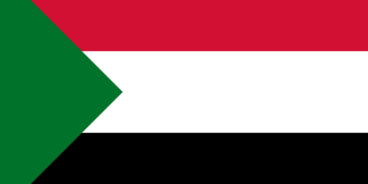
Open Letter to the Security Council on the situation in Sri Lanka, April 2009
The situation in Sri Lanka has reached a point of extreme urgency. With the government having resumed its military offensive after a two-day pause, the approximately 100,000 civilians trapped between the army and the rebel force, the Liberation Tigers of Tamil Eelam (LTTE), are now at grave risk of mass atrocities. The LTTE continues to shoot at non-combatants who try to leave and to use them as human shields, as a result few civilians were able to leave during the brief lull in fighting. Government forces, which have engaged in intense shelling and aerial bombardment both of the combat area and of an adjacent “no-fire zone,” are believed to be preparing a final assault. John Holmes, the UN Emergency Relief Coordinator, has stated that “a bloodbath . . . seems an increasingly real possibility.”
We are writing to you as members of the Security Council because we believe that the very grave risk of mass atrocities compels the international community, and the Security Council specifically, to take measures to protect civilians, as states pledged to do when they adopted the “responsibility to protect” at the UN World Summit in 2005. At the core of this norm is the obligation to act preventively to protect peoples from genocide, war crimes, crimes against humanity and ethnic cleansing, rather than waiting until atrocities have already occurred, as states have too often done in the past. There can be little doubt about either the magnitude, or the imminence, of the peril civilians now face in Sri Lanka. Navi Pillay, the UN High Commissioner for Human Rights, has stated that casualties may reach “catastrophic levels” if the fighting is not stopped.
We recognize that in the face of a ruthless insurgency the government of Sri Lanka has not only the right but the responsibility to protect its people. But states engaged in armed combat do not have the right to perpetrate atrocities against civilians; nor does the cruelty of an armed opponent absolve states of the responsibility to protect citizens from atrocities committed in the course of such a war.
We recognize as well that the current threat of mass atrocities arises at least as much from the behavior of the LTTE as it does from the Sri Lankan army. Nevertheless, the state has the sovereign obligation to protect its own people; and when, according to the terms of the World Summit Document, a state is “manifestly failing” to do so, the international community is obliged to act. While we view the two-day pause observed by the government of Sri Lanka as a preventive act in the spirit of the responsibility to protect, the army states that it has now returned to “normal operations.” The resumption of hostilities directed indiscriminately at military and civilian objects constitutes manifest failure both by the state and by the LTTE.
There is widespread agreement about what must be done immediately: The LTTE must allow those civilians who wish to leave to do so; in return, the government of Sri Lanka must agree to observe a more extensive ceasefire, guarantee the safety of those civilians and treat them according to international standards governing internally displaced peoples. Donors and others with close ties to the government of Sri Lanka must press for action, as must those with influence over the LTTE.
However, it is the Security Council, according to the terms of the 2005 agreement, which must authorize “timely and decisive measures” to prevent or halt mass atrocities. The Council must be prepared to bluntly characterize the violence in Sri Lanka as mass atrocity crimes; to demand that the government of Sri Lanka grant access to the conflict zone to humanitarian groups and to the media, both of whom it has barred until now; to dispatch a special envoy to the region, and/or to consider the imposition of sanctions. And ultimately, it must help facilitate a durable political solution to the fighting.
Signed:
-
-
- Jan Egeland, Director, Norwegian Institute of International Affairs, former UN UnderSecretary-General for Humanitarian Affairs, and member of the International Advisory Board, Global Centre for the Responsibility to Protect
- Gareth Evans, President of the International Crisis Group, former Australian Foreign Minister, and Co-Chair of the International Advisory Board, Global Centre for the Responsibility to Protect
- Juan Méndez, President, International Center for Transitional Justice, former UN Secretary General’s Special Adviser on the Prevention of Genocide, and member of the International Advisory Board, Global Centre for the Responsibility to Protect
- Mohamed Sahnoun, President, Initiatives of Change-International, former Special Adviser to the UN Secretary-General, and Co-Chair, International Advisory Board, Global Centre for the Responsibility to Protect
- Monica Serrano, Executive Director, Global Centre for the Responsibility to Protect
- Ramesh Thakur, Founding Director of Balsillie School of International Affairs, Distinguished Fellow, The Centre for International Governance Innovation in Waterloo, Professor of Political Science at the University of Waterloo in Canada, and member of the International Advisory Board, Global Centre for the Responsibility to Protect
- Thomas G. Weiss, Director of the Ralph Bunche Institute for International Studies, and member of the International Advisory Board, Global Centre for the Responsibility to Protect
-
Related Content


Atrocity Alert Special Issue: Children and Armed Conflict
